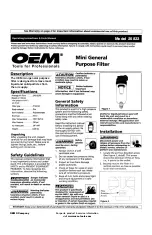
31
01040605 A 06/21
Arsenic Fact Sheet
Arsenic (abbreviated As) is found naturally in some well water� Arsenic in water has no color, taste or odor� It must be measured
by a lab test� Public water utilities must have their water tested for arsenic� You can get the results from your water utility� If you have
your own well, you can have the water tested� The local health department or the state environmental health agency can provide a list
of certified labs� The cost is typically $15 - $30� Information about arsenic in water can be found on the internet at the US Environmental
Protection Agency website: www�epa�gov/safewater/arsenic�html�
There are two forms of arsenic: pentavalent arsenic (also called As (v), As (+5), and arsenate) and trivalent arsenic (also called As (III),
As (+3), and arsenite)� In well water, arsenic may be pentavalent, trivalent, or a combination of both� Special sampling procedures are
needed for a lab to determine what type and how much of each type of arsenic is in the water� Check with the labs in your area to see if
they can provide this type of service�
Reverse osmosis (RO) water treatment systems do not remove trivalent arsenic from water very well� RO systems are very effective at
removing pentavalent arsenic� A free chlorine residual will rapidly convert trivalent arsenic to pentavalent arsenic� Other water treatment
chemicals such as ozone and potassium permanganate will also change trivalent arsenic to pentavalent arsenic� A combined chlorine
residual (also called chloramine) may not convert all the trivalent arsenic� If you get water from a public water utility, contact the utility to
find out if free chlorine or combined chlorine is used in the water systems�
The Aquasential RO and Smart RO Advanced Drinking Water Systems are designed to remove pentavalent arsenic� They will not convert
trivalent arsenic to pentavalent arsenic� The systems were tested in a lab� Under those conditions, the systems reduced 0�050 mg/L
(ppm) pentavalent arsenic to 0�010 mg/L (ppm) (the USEPA standard for drinking water) or less� The performance of the systems may be
different at your installation� Have the treated water tested for arsenic to check if the systems are working properly�
The RO component of the Aquasential RO and Smart RO Advanced Drinking Water Systems system must be replaced every 3-5 years to
ensure the systems will continue to remove pentavalent arsenic� The component identification and locations where you can purchase the
component are listed in the installation/operation manual�
The systems have been tested for the treatment of water containing pentavalent arsenic (also known as As (V), As (III), or arsenate)
at concentrations of 0�050 mg/L or less� These systems reduce pentavalent arsenic, but may not remove other forms of arsenic�
These systems are to be used on water supplies containing a detectable free chlorine residual or on water supplies that have been
demonstrated to contain only pentavalent arsenic� Treatment with chloramine (combined chlorine) is not sufficient to ensure complete
conversion of trivalent arsenic to pentavalent arsenic� Please see the Arsenic Fact section of the Performance data Sheet for further
information�
Arsenic (As) is a naturally occurring contaminant found in many ground waters� It generally occurs in two forms (valences or oxidation
states): pentavalent arsenic (also known as As(V), As(+5), and arsenate) and trivalent arsenic (also known as As(III), As(+3), and
arsenite)� In natural ground water, arsenic may exist as trivalent arsenic, pentavalent arsenic, or a combination of both� More information
about arsenic and its toxicity can be found at the Agency for Toxic Substances and Disease Registry Toxicological Profile on Arsenic
website at http://www�atsdr�cdc�gov/toxprofiles/phs2�html, and at the U�S� Environmental Protection Agency website at http://www�epa�
gov/safewater/arsenic�html�
Arsenic does not generally impart color, taste, or smell to water; therefore, it can only be detected by a chemical analytical test� Public
water supplies are required to monitor delivered water for arsenic (trivalent arsenic plus pentavalent arsenic) and the results are
available to the public from the utility� Consumers using private water sources will need to make arrangements for testing� An arsenic
test usually costs about $15-30, and it is recommended that the test be conducted by a certified laboratory� Local health departments or
environmental protection agencies can help provide consumers with a list of certified laboratories� Some laboratories may also be able to
analyze specifically for (speciate) the form(s) of arsenic present in a water sample if requested�
The Aquasential RO and Aquasentail Smart RO systems with AS3 1 and AS3 2 following an RO are designed to reduce arsenic: both
pentavalent and trivalent forms of arsenic� These treatment systems are tested under laboratory condition as defined in NSF/ANSI 53
Drinking Water Treatment Units - Health Effects and are found to reduce [influent arsenic challenge concentration 0�050 mg/L] arsenic
consisting of either pentavalent or trivalent arsenic in the test water to less than 0�010 mg/L, for [tested treatment capacity] gallons of
delivered water, the life of the systems under standard testing conditions� Actual performance of the systems may vary depending on
specific water quality conditions at the consumer’s installation� Following installation of this system, the consumer should have the treated
water tested for arsenic to verify that arsenic reduction is being achieved and the systems are functioning properly�
The arsenic removal component of these systems must be replace at the end of its useful life of 1,000 gallons (AS3-1) and 2,000 gallons
(AS3-2)� The replacement components, AS3 1, AS3 2, RO 50, and RO 75 can be purchased from your local Culligan dealer�



































